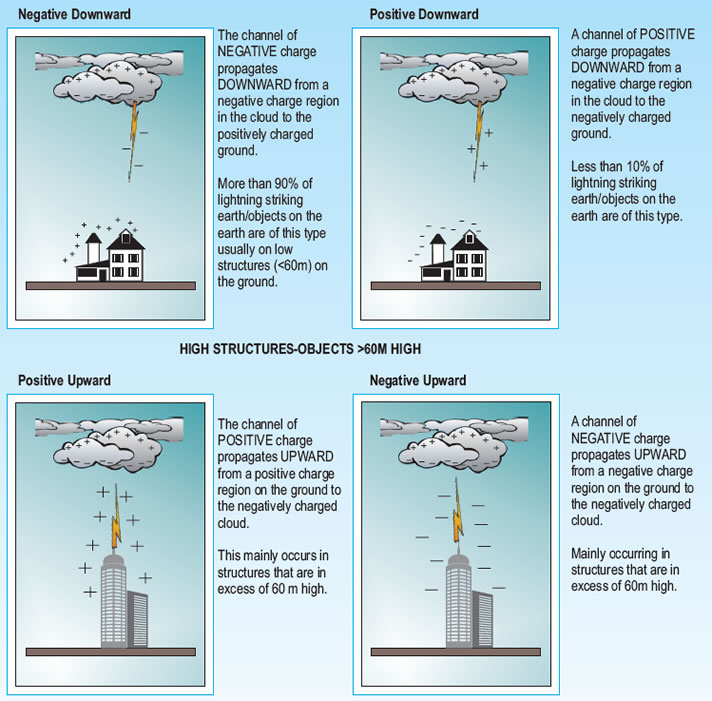LIGHTNING FORMATION (Negative Downward)
|
CLOUD CHARGE
Lightning is produced by cumulo-nimbus storm clouds. With the warm air rising, it creates
turbulence in the clouds. Friction in the cloud particles forms an electrical charge in the particles.
Thus the upper part of the cloud consists of positively charged ice crystals, while the base
consists of negatively charged water droplets. Atmospheric turbulence generates this electrical charge separation and,
once a disruptive limit is reached, an electrical discharge takes place between cloud and ground.
In fine weather, the electrical field on the ground is approximately 150kV/m. As the storm approaches, it increases and reaches levels of 15-20 kV/m. The potential difference between the cloud and the ground then amounts to several megavolts. |
|
DOWNWARD LEADER or TRACER
A slightly luminous pre-discharge, a DOWNWARD LEADER or TRACER, escapes from the base of
a normally negatively charged cloud, and travels towards the ground by leaps of tens of metres,
depending on the space charges. In actual fact, a sequence of discharges follows the ionised
path of this tracer, with pauses of 40 to 100us, thus giving an advance of about 0.15m/s. As it
approaches the ground, the highly charged tip of the DOWNWARD LEADER generates a sharp
increase in the electrical field, (about 500kV/m) |
|
UPWARD STREAMER
When the atmospheric air reaches the ionisation threshold (30 kV/m), charges leave
characteristic points on the ground and become positive ascending discharges, as the electrical
field increases.
The positive ascending discharge UPWARD STREAMER that has the best arcing properties, or
which advances the fastest, connects with the DOWNWARD LEADER. |
|
DOWNWARD LEADER - UPWARD STREAMER
The positive ascending discharge UPWARD STREAMER which has the best arcing properties,
or
which advances the fastest, connects with the DOWNWARD LEADER. The”other” upward
streamers “collapse” and the charge between the cloud and the object becomes neutralised as
shown in the Lightning Bolt/Flash step below.
Visibly this is still slightly luminous. |
|
LIGHTNING BOLT or FLASH
The ionised path is then complete and electrical charges from the ground (return strokes) join
the clouds, neutralising its electrical charge. In a very short space of time (0.25 to 1 second)
several bolts may be exchanged, and they advance continuously at a speed around 106 m/s.
Visibly this is a bright luminous flash. It appears to “flicker” which is repeated lightning bolts
travelling down the ionised path of the first strike. |
|
LIGHTNING STOPS
Once the cloud has discharged, the lightning ceases. As the turbulence continues in the cloud,
so the process starts all over. |
| LIGHTNING CHARGE ON LOW AND HIGH STRUCTURES |
LOW STRUCTURES <60m
As the majority of lightning strikes terminating on low structures(<60m) on the ground are Cloud to Ground.
|
HIGH STRUCTURES >60m
Lightning bolts rising upward from high structures (>60m) are Ground to Cloud. |
|
We need to concern ourselves with:-
FOUR types of lightning that are the cause of structural damage, business interruption,
electronic equipment failure, casualties and even death are described below :
LOW STRUCTURES-OBJECTS <60M HIGH

|